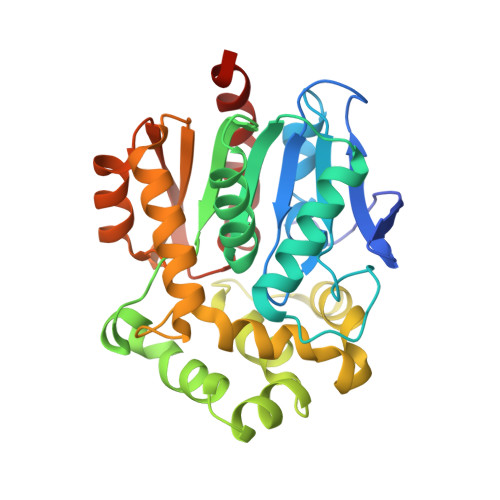Atomic resolution studies of haloalkane dehalogenases DhaA04, DhaA14 and DhaA15 with engineered access tunnels.
Stsiapanava, A., Dohnalek, J., Gavira, J.A., Kuty, M., Koudelakova, T., Damborsky, J., Kuta Smatanova, I.(2010) Acta Crystallogr D Biol Crystallogr 66: 962-969
- PubMed: 20823547
- DOI: https://doi.org/10.1107/S0907444910027101
- Primary Citation of Related Structures:
3FBW, 3FWH, 3G9X - PubMed Abstract:
The haloalkane dehalogenase DhaA from Rhodococcus rhodochrous NCIMB 13064 is a bacterial enzyme that shows catalytic activity for the hydrolytic degradation of the highly toxic industrial pollutant 1,2,3-trichloropropane (TCP). Mutagenesis focused on the access tunnels of DhaA produced protein variants with significantly improved activity towards TCP. Three mutants of DhaA named DhaA04 (C176Y), DhaA14 (I135F) and DhaA15 (C176Y + I135F) were constructed in order to study the functional relevance of the tunnels connecting the buried active site of the protein with the surrounding solvent. All three protein variants were crystallized using the sitting-drop vapour-diffusion technique. The crystals of DhaA04 belonged to the orthorhombic space group P2(1)2(1)2(1), while the crystals of DhaA14 and DhaA15 had triclinic symmetry in space group P1. The crystal structures of DhaA04, DhaA14 and DhaA15 with ligands present in the active site were solved and refined using diffraction data to 1.23, 0.95 and 1.22 A, resolution, respectively. Structural comparisons of the wild type and the three mutants suggest that the tunnels play a key role in the processes of ligand exchange between the buried active site and the surrounding solvent.
- Institute of Physical Biology, University of South Bohemia, Nove Hrady, Czech Republic.
Organizational Affiliation:



















